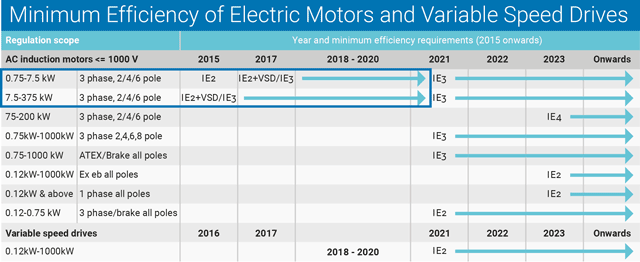Efficiency regulations for hazardous area motors are changing, but Andy Glover, product manager at WEG UK, says the new energy efficiency requirements could provide significant financial gain.

Europe has over 8 billion electric motors in use, consuming approximately 50% of the electricity generated across the continent. Until recently, some of these motors, including those designed for hazardous areas, were exempt from energy efficiency regulations – but these regulations are about to change. The changes will include a wider range of motors, and for the first time variable speed drives will be required to achieve a higher efficiency standard, starting from July 2021.
The Minimum Energy Performance Standard (MEPS) was introduced in 2009 by EU Commission Regulation EC 640/2009. The regulation required motors of 0.75-375kW to reach international standards set by the International Electrotechnical Commission (IEC) for single-speed three-phase motors. IE1 describes standard efficiency, IE2 is high efficiency and IE3 is used for motors with premium levels of efficiency.
Updates to the legislation in 2016 specified that electric motors require an energy efficiency class of at least IE3, or IE2 if the motor is used with a variable speed drive (VSD). The regulation, bolstered by improved design and materials for electric motors, brought about huge reductions in energy consumption related to motor use.
Now the European Commission’s ecodesign committee has approved a new, stricter version of the ecodesign requirements, which take effect from 1 July, 2021.
Previously, the scope of the regulations only covered three-phase motors ranging from 0.75kW to 375kW, leaving motors outside this power range excluded. From 2021, this will no longer be the case. The impending regulation requires all new 2-, 4-, 6- and 8-pole motors in the power range of 0.75-1000kW to meet IE3 efficiency. The previous legislation allowed for an IE2 motor to be used provided it was controlled by a VSD, but this will no longer be the case. Motors from 0.12-0.75kW will need to meet IE2 standard.
Special purpose motors, such as explosion-proof (Atex) or flameproof motors, were exempt from the previous regulation, out of precaution for the higher-risk environments they were used in. From July 2021, new Atex motors entering the supply chain must be rated IE3 or higher with increased safety motors. The exception is for motors rated ‘Ex eb’ – these motors will need to be at least IE2 efficiency by 2023.
The outcome of Brexit will have little effect on the new legislation, as the UK follows EU motor legislation. Though this could change in the future, there is no indication that the UK intends to produce its own set of rules in the near future.
The table below shows the proposed scope, corresponding ambition levels and timeline, the area boxed in blue corresponding to the current measure.

WEG’s hazardous area motors meet the new energy efficiency standards – and had done long before the regulatory changes were announced. In addition the WEG range of IE3 hazardous area motors are manufactured to IEC standards.
WEG also has a super-premium range of safe area and hazardous area IE4 motors. This will prove useful because from 2023, safe area motors between 75kW and 200kW that are not brake motors or hazardous area motors will be required to meet efficiency class IE4.
Energy costs for electric motors account for 95 to 97% of total life cycle costs, depending on the application. In energy-intensive industries, such as chemical, pharmaceutical or oil and gas, thousands of motors operate 24 hours a day. Even a slight improvement in efficiency will benefit a business’s bottom line. Investment in energy-efficient drives and motors usually provides a very short return on investment.
www.weg.net | e-mail: info-uk@weg.net
A guide to the new ecodesign requirements, including the table above, can be downloaded from http://static.weg.net/medias/downloadcenter/hd7/h5b/WEG015-changes-to-motor-legislation.pdf

